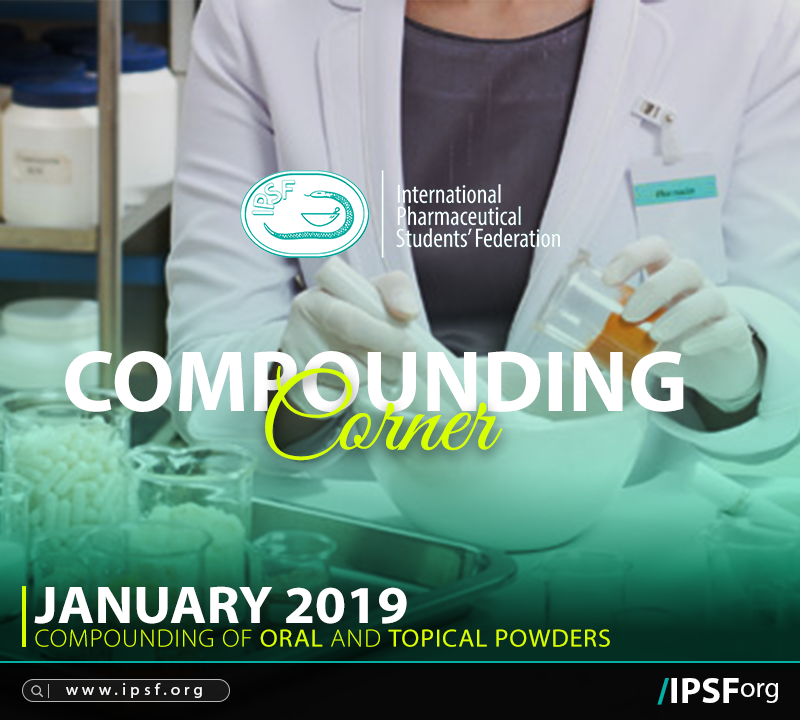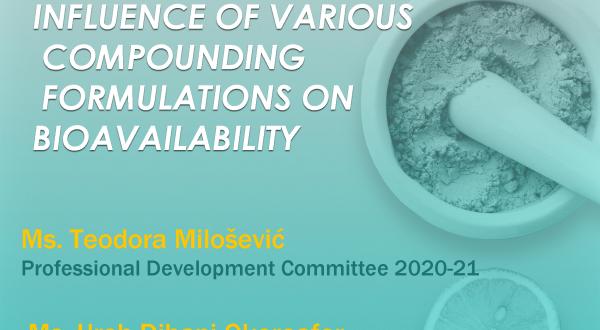
Compounding Corner January 2019
Compounding of Oral and Topical Powders (January 2019)
Powder is a dry preparation of medicinal or chemical ingredients, for oral use or for external use. Oral powders are preparations suitable for children and adults who find it difficult to swallow capsules or tablets. Powders have a large surface area that is more soluble and dispersed than other solid dosage forms. Powder formulations are homogeneous, dry, with uniformity of content. Topical powder must be free of Clostridium Tetani, Clostridium Welchii, and Bacillus Anthracis bacteria.
Powder classification
1. Oral Powder
Oral powder can either be in a divided or an undivided form.
Oral divided powder is, powder that is packaged and intended as a single dose. Whereas, for oral undivided powder it can be given as multiplel doses over several time interval. such as; laxative, antacids e.t.c (the condition of undivided powder is that the drug is relatively non-potent to avoid dosing errors).
2. Topical Powder
Topical powder is a powder intended for external use. For examples, Dusting powders, Tooth powders.
The principle of powder mixing
Powder mixing can be used to maintain powder homogeneity and the availability of active ingredients in the powder so that there is no active ingredient attached to the mortar wall.
1. Potential drugs are mixed with fillers
2. Drugs in the form of crystals, before mixing must be crushed
3. Drugs that have different colors, must be mixed until they are homogeneous
4. Medicines that have a small volume or amount must be mixed first, then drugs with a larger volume or amount
Steps in preparing powders
1. Particle size reduction.
This aims to enlarge the surface area, so that the powder can be more easily dissolved and dispersed. while, Topical powders do not cause irritation to the skin after use. The degree of fineness of a powders is expressed as the percentage of powder that passes the sieve size that meets the specifications.
Here is the degree of fineness of a powders according to BP 2013
|
Degree of fineness |
Not less than 95% by mass passes through a number |
Not more than 40% by mass passes through a number |
|
Coarse powder |
1400 sieve |
355 sieve. |
|
Moderately fine powder |
355 sieve |
180 sieve |
|
Fine powder |
180 sieve |
125 sieve |
|
Very fine powder |
125 sieve |
90 sieve |
Reducing particle size can be done in two main ways:
a. Trituration.
Is a process of reducing particle size using mortars and pestle. Trituration is used when working with hard and fracturable powders.
b. Pulverization by Intervention
Pulverization by intervention is used with hard crystalline powders that do not crush or triturate easily, gummy type substances. In pulverization by intervention, we use solvent (such as alcohol or acetone) that will dissolve the compound, and then mixed in a mortar, and evaporation of the solvent Is then carried out.
2. Mixing of powders. This aims to form homogeneous and evenly mixed powder preparations. Homogeneity of the preparation is very important because it is related to the uniformity of content and effectiveness of treatment. Some powder mixing methods are as follows.
a. Trituration
It is a mixing process using a mortars and pestle. This method is commonly used by pharmacists.
b. Geometric dilution.
The active ingredient (potent drug) is placed in a mortar, then added to an approximately same amount of the fillers / diluent. This is mixed quickly by trituration. After being homogeneous, the mixture is added to another approximately same amount of filler and mixed again by trituration. The process continues until all the fillers is added.
c. Spatulation
It is a method of mixing powder using a spatula on a piece of paper. This can be used for mixing solid ingredients that can liquefy or form eutectic mixtures.
d. Tumbling by mechanical mixing
It is a mixing method using tools with large rotating container such as powder blenders, V-blend, etc. This method is usually done in industry for mixing on a large scale.
3. Packaging of powders
a. Oral powders
Oral divided powders can be wrapped in parchment paper or other types of paper and then put into a card-box or plastic. The packaging of oral undivided powders can use plastic pots or large-mouthed jars that make it easy to take.
b. Topical powders
Topical powders especially dusting powders can be packed in containers with holes such as sieves or in large-mouthed containers.
References
- Allen, L. V., Popovich, N. G., Ansel, H. C., & Ansel, H. C. (2005). Ansel's pharmaceutical dosage forms and drug delivery systems. Philadelphia: Lippincott Williams & Wilkins.
- British Pharmacopoiea Commision. (2013). British Pharmacopoiea. London: The. Pharmaceutical Press.
- Christopher A Langley, Dawn Belcher. (2012) FASTtrack: Pharmaceutical Compounding and Dispensing. London: Pharmaceutical Press.
- Marriott J F, Wilson K A, Langley C A, Belcher D (2006) Pharmaceutical Compounding and Dispensing. London: Pharmaceutical Press.
Example cases
Prescription:
|
Date. |
05 January 2019 |
|||
|
Patient’s Information |
Name |
John |
Doctor’s Name |
Ken |
|
Date of birth / Age |
05 July 1997 / 21 years |
Doctor’s Signature |
Ken |
|
|
Calamine Dusting Powders 15% BP 200 g |
||||
|
Direction |
Apply the dosage to the affected areas two times a day |
1. Compound Name:
2. Content of the compounded medicine in active pharmaceutical ingredient:
3. Pharmaceutical form:
4. Quantity of the compounded medicine:
5. Route of administration :
6. Beyond-Use Date:
7. Formulation
|
Ingredient |
Quantity |
Organoleptic |
Function |
|
|
|
|
|
|
|
|
|
|
8. Calculations for the amounts of prescribed drugs
|
Ingredient |
Quantity |
Quantity Calculated |
|
|
|
|
|
|
|
|
9. Method of preparation
10. Compound label
Patient: Manufacturing Date: ________________
Drug: Strength (% w/w):
Indication:
Directions:
Storage:
Pharmacist name: Amount:



